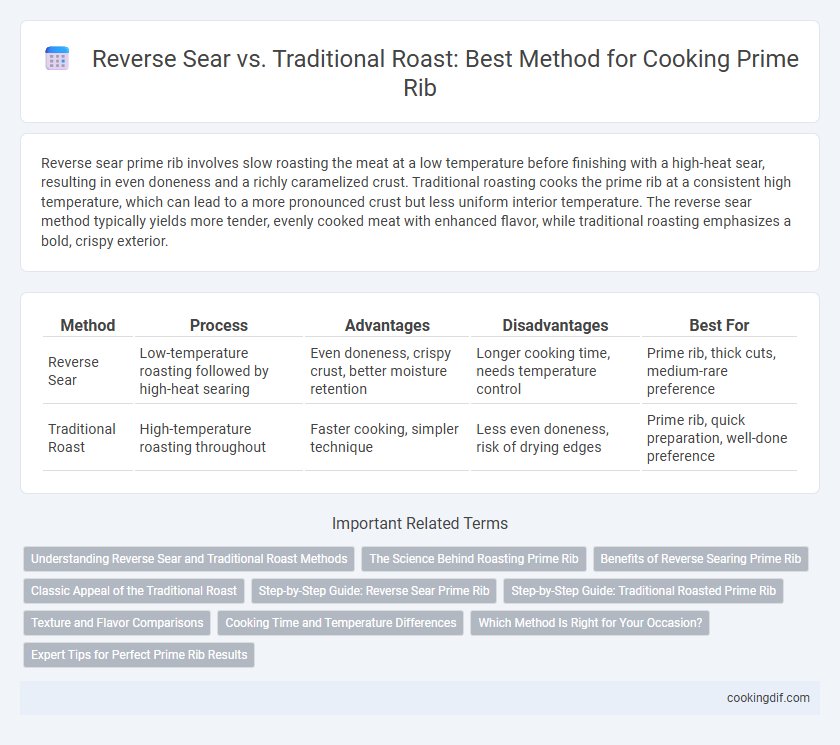Reverse sear prime rib involves slow roasting the meat at a low temperature before finishing with a high-heat sear, resulting in even doneness and a richly caramelized crust. Traditional roasting cooks the prime rib at a consistent high temperature, which can lead to a more pronounced crust but less uniform interior temperature. The reverse sear method typically yields more tender, evenly cooked meat with enhanced flavor, while traditional roasting emphasizes a bold, crispy exterior.
Table of Comparison
| Method | Process | Advantages | Disadvantages | Best For |
|---|---|---|---|---|
| Reverse Sear | Low-temperature roasting followed by high-heat searing | Even doneness, crispy crust, better moisture retention | Longer cooking time, needs temperature control | Prime rib, thick cuts, medium-rare preference |
| Traditional Roast | High-temperature roasting throughout | Faster cooking, simpler technique | Less even doneness, risk of drying edges | Prime rib, quick preparation, well-done preference |
Understanding Reverse Sear and Traditional Roast Methods
Reverse sear and traditional roast methods differ primarily in cooking sequence and temperature control, impacting prime rib's texture and flavor. Reverse sear involves slow roasting the prime rib at a low temperature until nearly done, followed by a high-heat sear to create a caramelized crust, enhancing juiciness and even doneness. Traditional roast cooks the meat at a higher temperature throughout, which develops a browned exterior early but can result in a gradient of doneness from edge to center.
The Science Behind Roasting Prime Rib
Reverse sear prime rib cooking involves slowly roasting the meat at a low temperature to ensure even heat penetration, followed by a high-heat sear to develop a flavorful crust through the Maillard reaction, preserving juiciness and tenderness. Traditional roasting applies high heat from the start, which can cause uneven cooking with a pronounced gradient from the outer crust to the less cooked interior. Understanding the thermal conductivity of meat and the enzymatic activity during slow cooking explains why reverse searing enhances flavor development and texture by maintaining optimal internal temperature while maximizing surface browning.
Benefits of Reverse Searing Prime Rib
Reverse searing prime rib delivers superior flavor development and a perfectly even cook by slowly bringing the meat to an ideal internal temperature before a high-heat finish. This method enhances juiciness and tenderness while creating a more pronounced, flavorful crust compared to traditional roasting. Reverse searing also reduces the risk of overcooking, ensuring a consistent medium-rare center throughout the prime rib.
Classic Appeal of the Traditional Roast
The traditional roast method for prime rib offers a classic appeal by slowly cooking the meat at a consistent temperature, ensuring an evenly tender and juicy interior with a flavorful crust. This time-honored technique highlights the rich, beefy flavor and maintains a uniform doneness throughout the cut. Many chefs and home cooks prefer the traditional roast for its simplicity and reliable, restaurant-quality results.
Step-by-Step Guide: Reverse Sear Prime Rib
Start by seasoning the prime rib generously with salt and pepper, then roast it slowly at a low temperature of 225degF (107degC) until the internal temperature reaches 120degF (49degC). Remove the roast and let it rest while heating a cast-iron skillet or oven to 500degF (260degC) for the searing step. Sear all sides of the prime rib for 2-3 minutes until a deep brown crust forms, enhancing flavor and texture before serving.
Step-by-Step Guide: Traditional Roasted Prime Rib
Traditional roasted prime rib begins by seasoning the meat generously with salt, pepper, and herbs before placing it in a preheated oven at 450degF to sear the exterior for 20 minutes. After searing, reduce the oven temperature to 325degF and continue roasting until the internal temperature reaches 130degF for medium-rare, typically about 15 minutes per pound. Resting the prime rib for at least 20 minutes allows the juices to redistribute, ensuring a tender and flavorful roast.
Texture and Flavor Comparisons
Reverse sear yields a more evenly cooked prime rib with a tender, juicy interior and a consistent crust developed through low-and-slow roasting followed by high-heat searing, enhancing Maillard reactions for rich, complex flavor. Traditional roasting often produces a gradient of doneness with a firmer outer layer and a less uniformly cooked center, potentially leading to a less tender texture and milder flavor development. Texture differences are pronounced, with reverse sear delivering superior juiciness and a crisp, flavorful bark compared to the sometimes drier crust of traditional roasting methods.
Cooking Time and Temperature Differences
The reverse sear method for prime rib involves slow-roasting the meat at a low temperature of around 225degF to 275degF until it reaches an internal temperature of 115degF to 120degF, followed by a high-heat sear at 500degF to 550degF to create a crispy crust, resulting in a longer total cooking time but more even doneness. Traditional roasting cooks prime rib at a consistently high temperature, usually between 325degF and 450degF, finishing more quickly but often with less uniform internal temperature. The reverse sear technique offers better control over cooking time and internal temperature gradients, reducing the risk of overcooked edges compared to traditional roasting.
Which Method Is Right for Your Occasion?
Reverse sear offers precise temperature control and superior crust development, making it ideal for achieving medium-rare prime rib with consistent doneness throughout. Traditional roast suits larger gatherings where convenience and simplicity are priorities, as it requires less monitoring and delivers a classic, evenly cooked roast. Consider reverse sear for gourmet meals demanding perfect texture and flavor; choose traditional roast for timeless preparation and ease in serving multiple guests.
Expert Tips for Perfect Prime Rib Results
Experts recommend reverse sear for prime rib as it ensures consistent internal temperature and a juicy, tender crust by slowly cooking the meat before searing. Traditional roast often results in uneven doneness, with the exterior overcooked while the center remains underdone. For perfect prime rib, use a meat thermometer to monitor internal temperature closely and rest the meat after cooking to retain juices and enhance flavor.
Reverse sear vs Traditional roast for prime rib Infographic

 cookingdif.com
cookingdif.com